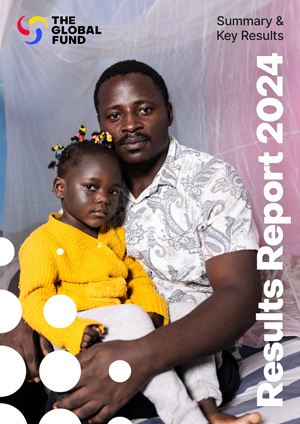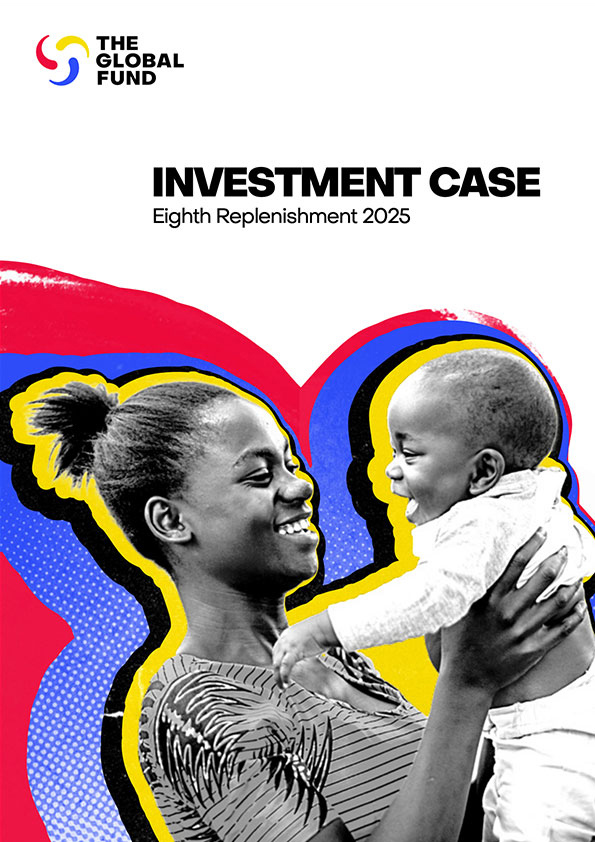Global Fund Report Highlights Major Strides Against HIV, TB and Malaria, Lowered Prices for Essential Medicines
19 September 2024
GENEVA – Investments in the fight against HIV, tuberculosis (TB) and malaria have saved a total of 65 million lives and cut the combined death rate from the three diseases by 61% since 2002, according to a new report by the Global Fund to Fight AIDS, Tuberculosis and Malaria.
“Those are not mere numbers,” said Peter Sands, Executive Director of the Global Fund. “Each of the 65 million lives saved by our partnership is a family member, a friend, a neighbor, a teacher, a worker. Every life saved, and every infection averted, has a multiplier effect across families, communities and entire nations.”
Over the last two decades, the impact achieved by the Global Fund partnership has led to dramatic improvements in life expectancy: Global inequality in life expectancy across countries declined by one-third between 2002 and 2019. Half of this decline is due to reduced mortality from AIDS, TB and malaria.
Progress vs. challenges
In 2023, Global Fund-supported programs to fight HIV, TB and malaria achieved a complete recovery from the disruptions caused by COVID-19, the report shows.
On the HIV front, the Global Fund partnership sustained progress in rolling out HIV treatment, with a record 25 million people now on antiretroviral therapy. In 2023, the partnership also conducted 53.8 million HIV tests, and reached 17.9 million people with HIV prevention services. It supported increased access to effective prevention options, including oral pre-exposure prophylaxis (PrEP) and the dapivirine vaginal ring. However, human rights barriers like punitive laws, policies and practices such as stigma, discrimination and violence, including gender-based violence, persist and prevent people in many regions of the world from having access to HIV prevention, testing, treatment and care.
“The fight against diseases is as much a fight for justice and equity as it is a biomedical fight,” said Sands. “Even the most innovative biomedical tools will fail if those who most need them can’t get them.”
TB programs supported by the Global Fund recorded a complete recovery from COVID-19-related disruption. By leveraging innovative tools and novel approaches, including mobile diagnostic units and artificial intelligence (AI) capabilities in screening, such as AI-powered computer-aided detection software and digital chest X-rays, more people with TB were found and treated than ever before. Over 7.1 million people with TB were treated, 121,000 received treatment for drug-resistant TB, and 2 million people exposed to TB received preventive therapy. Yet drug-resistant TB – one of the largest causes of antimicrobial resistance-related mortality – is a growing threat.
On malaria, the Global Fund accelerated the equitable deployment of tools for prevention, testing and treatment. Main achievements include the distribution of 227 million mosquito nets, the testing of 335 million suspected malaria cases, and the treatment of 171 million malaria cases. A total of 44.6 million children received seasonal malaria chemoprevention. Malaria remains a daunting global health challenge, as conflict, climate change and increasing resistance to insecticides are jeopardizing the significant gains made against the disease over the last two decades.
Stronger health and community systems
The report also illustrates the transformative contribution of the Global Fund partnership, beyond the three diseases, to strengthening health and community systems, reducing global health inequities, and accelerating progress toward universal health coverage (UHC).
For example, it demonstrates – for the first time – how Global Fund investments in HIV over the last two decades have kept millions of people healthy, freeing up 1.66 billion hospitalization days that would have otherwise been used for HIV-related activities and averting 1.36 billion outpatient visits, generating US$85 billion in cost savings.
“Where the three diseases absorb over 50% of health system resources, the impact of reducing their burden on overall health system performance can be dramatic,” said Sands. “It means lower infant and maternal mortality and fewer deaths from acute trauma and other conditions. In addition, our continued investments in community health workers, labs, supply chains, disease surveillance systems and other health system components better prepare countries to prevent, detect and respond to other diseases like mpox or future pandemics.”
In 2023, the Global Fund invested the highest amount ever in a year – US$1.8 billion – to strengthen health and community systems. Between 2024 and 2026, the Global Fund plans to invest up to US$6 billion in health and community systems to support countries to improve health outcomes across all diseases, build pandemic preparedness and work toward achieving UHC.
Market-shaping impact
The Global Fund is committed to driving equitable access to quality-assured health products and innovations. It uses its scale to shape markets by encouraging manufacturers to meet global quality requirements, to secure increased supply capacity for low- and middle-income countries, and to lower health product prices.
In 2023, those efforts resulted in major price reductions for key commodities across the three diseases, enabling countries to increase coverage and reach more people. For HIV, the Global Fund and partners secured a 25% price reduction for TLD, the preferred first-line HIV treatment. For TB, the partnership reduced prices by 20% for diagnostic test cartridges, by 30% for 3HP, the short-course TB preventive treatment, and by 55% for bedaquiline, the main treatment for drug-resistant TB. Leveraging the newly created Revolving Facility, the Global Fund accelerated the scaled introduction of new dual active ingredient insecticide-treated mosquito nets by achieving sustainable pricing for this new net, which is >45% more effective against malaria than existing insecticide-treated nets.
Colliding crises, deepened partnerships
In 2023, the world was again hit by multiple crises, including climate change, conflict, and attacks on human rights, gender equality and civil society. These crises have a direct impact on the fight against HIV, TB and malaria.
In response, the Global Fund adapted its interventions to provide agile support through grant flexibilities, reprogramming and provision of emergency funding. For instance, it has reprogrammed its grants to better serve communities caught up in the intensifying conflicts in Sudan, Ukraine and the Middle East. To support countries to adapt to the impact of extreme weather and climate events, it restructured grants as well as offered access to emergency funds in countries such as Zambia, Kenya and Somalia. The Global Fund invests 70% of its funding in the 50 most climate-vulnerable countries. To tackle human rights and gender-related barriers to accessing health services, the partnership expanded the Breaking Down Barriers initiative, ensuring inclusivity and equity in health care delivery.
“Our model is anchored by a partnership that thrives on inclusive governance, making us a global movement of civil society, governments, private sector partners, technical partners and communities affected by the three diseases in more than 100 countries,” said Sands. “That partnership came to count enormously as we responded to the many challenges we faced in the year.”
The Global Fund is committed to maximizing the collective impact of global health efforts, especially as the world confronts a host of colliding crises. It has already established several wide-ranging workstreams with partners, including Gavi, the Vaccine Alliance and the Global Financing Facility, and will continue to work closely with long-standing partners such as the World Health Organization, the World Bank, Unitaid and others to save more lives and accelerate progress toward Sustainable Development Goal 3 of health and well-being for all.







